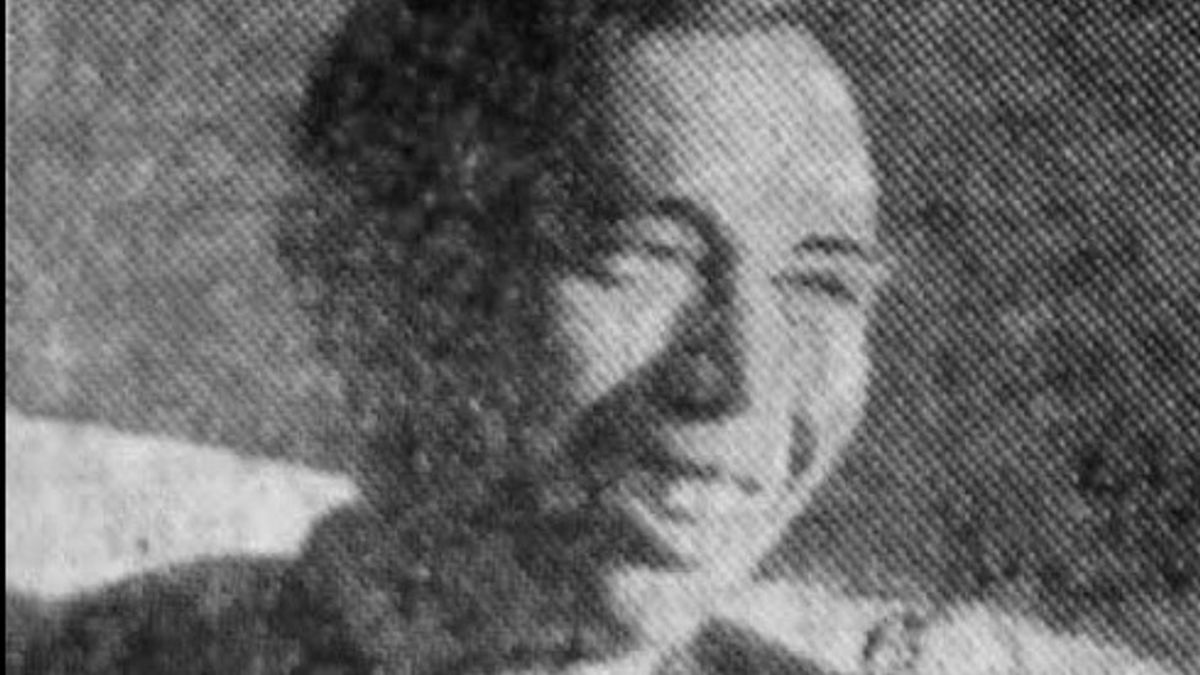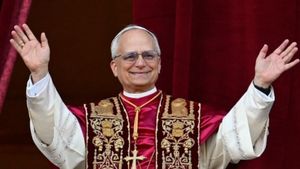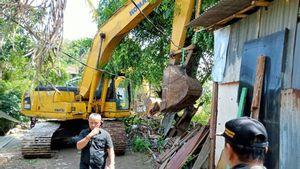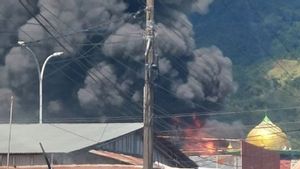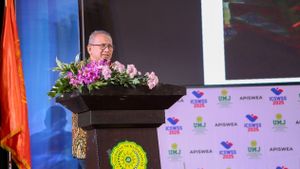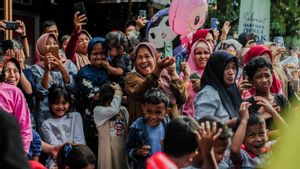JAKARTA - His name may often be ignored by some people because of the ideology he adheres to. However, its role in independence, especially for the workers, cannot be underestimated. He is Semaun, a revolutionary figure born in Mojokerto in 1899. Born from a family with a mediocre economy, Semaun can only study at Tweede Klas, a school for natives.
Since childhood, Semaun was known as a smart child. Armed with that elementary school diploma, Semaun was accepted to work at the Staats Spoor Maatschapi (State Railway Company) at the age of 13. Even though he is busy with work, his desire to study never goes out. Every afternoon he took the time to study Dutch at Hollandsch Inlandsce School (HIS).
With his position as a railroad employee, at that time he was actually quite established and his life was guaranteed. However, because of the increasing suffering of the people he saw at that time, Semaun was moved to carry out a liberation movement. Semaun also left his job from the railroad company to participate in the national movement.
Semaun joined the Sarekat Islam (SI) organization at a young age, 15 years old. At SI, Semaun held the position of Secretary of the Sarekat Islam for the Surabaya branch. Semaun's entry into the SI movement brought him together with Henk Sneevliet. According to Soewarsono, a historian of the Indonesian Institute of Sciences (LIPI), Semaun's meeting with Sneevliet took place in Surabaya in 1915.
The meeting with Sneevliet pushed him into VSTP and ISDV. “A meeting that gave birth to her admiration for Sneevliet's sincerity and human attitude. And because of that, (Semaun) accepted Sneevliet's offer for Semaun to enter the VSTP and ISDV afdeeling Surabaya, "wrote Soewarsono in Moving Together, A Piece of Semaun's History and Thought.
Semaun was also interested because according to him VSTP and ISDV were sympathetic to the struggle of the Indonesian nation against colonialism. In the congress that was later held, Semaun was elected as Deputy Chair of the VSTP and ISDV. Since then he has chosen to focus in the organization and gave up his career as a railroad employee, then moved to Semarang.
Semaun's organizational expertise is also evident in SI. In the SI Semarang Congress in 1917, he was elected chairman of SI Semarang. At that time, he was 18 years old. Under his leadership, SI Semarang developed rapidly. SI members increased to tens of thousands of people, from 1,700 members in 1916 to 20,000 in 1917. SI also spread to the villages.
In 1918, the SI Semarang branch decided to hold an open meeting in the field near Tawang Station. The goal is that the decision can be heard by the wider community. SI members also went to a wide field to expand their network. As a differentiator, SI members are required to wear a cap that is usually used by farmers.
Unexpected. The action turned into a unique demonstration. This action was also followed by the general public, who initially were only spectators. The traffic was almost paralyzed as a result of the action, which made it difficult for the colonial police in Semarang. Shouts of enthusiasm were also sparked throughout the action. The demonstrators chanted various slogans such as "Long live SI", "Long live the Social Democrats", "Long live Semaun."
Semaun that is getting "left"
This incident further popularized the name Semaun among the people. In 1919, at the age of 20, Semaun was elected as a member of the SI central leadership and concurrently as Chairman of the SI Semarang branch. Semaun is also active in writing in the mass media. In fact, as a result of his writing, Semaun was imprisoned in Yogyakarta from July to November 1919. In prison, he kept himself busy writing a novel entitled Hikayat Kadirun and a book entitled Guidance for the Workers.
Through the Guidance of the Workers, Semaun expressed the idea for workers to move by telling the condition of the Dutch East Indies when there was no imbalance, "When Indonesia did not have railings or trams (trains), the country was quiet, lonely, peaceful, and peaceful. its inhabitants (people) who live, think, have wisdom, and work patiently and peacefully. Almost all Indonesians own a piece of land that provides income and livelihood for them. " Semaun wrote in his book.
Out of prison, Semaun returned to Semarang. His attitude towards the Dutch East Indies government was increasingly radical. Semaun really applied Sneevliet's teachings. He developed into a violent propagandist of socialism. This side also brought changes to the SI which was originally soft in the Dutch East Indies. Left style, over time it becomes more visible in SI. Semaun's strong influence made the other SI leaders struggle to balance the left of the organization.
In fact, wealthy people like Niti Semito, king of kretek cigarettes from Kudus or Haji Busro from Semarang also supported SI ala Semaun. Many of the labor strikes were supported by these local entrepreneurs. HOS Tjokroaminoto responded to Semaun's movement by writing a book entitled Islam and Socialism. The book explains that socialism exists in Islamic teachings.
Concerns arose. Central SI leaders who wanted Islamic principles in SI began to see Semaun as a danger. SI ala Semaun is considered off the mark because it is too left. This concern grew even more acute when Semaun founded the Indies Communist Association (PKH) on May 23, 1920, when the SI leader, HOS Tjokroaminoto was confronted with allegations of corruption - although later it was not proven.
At that time, the leaders of the Central Sarekat Islam, namely Agus Salim and Soerjopranoto, tried to expel the communists who were deemed incompatible with Islamic values. The Semarang SI branch under the leadership of Semaun was the target of this control. Quoted from the Historia page, the CSI leadership meeting was held in Yogyakarta on September 30, 1920 without the presence of the chairman of SI, HOS Tjokroaminoto, who had to attend the trial. Semaun did not attend because he attended the International Communist Congress in Moscow, Russia.
Apart from cleaning up the Communist elements in SI's body, the meeting also resulted in a decision to move the central SI from Surabaya to Yogyakarta. On May 24, 1922, Semaun returned from Moscow to his homeland, where he restarted the movement among the workers. The climax of the series of strike actions took place in February 1923. These actions arose as a result of the Dutch East Indies government reducing workers' salaries. The strike action of the railroad workers who are members of the VSTP also took place. The strikes exploded in several cities.
Not only railroad workers. The colonial police from among the natives also took part in the strike. Quoted from the newspaper Kaoem Moeda, February 2, 1923 edition, which reported that many low-ranking indigenous police went on strike to demand their allowances. The mass strike in various cities made the Dutch East Indies government furious.
In exile
As a result, on May 8, 1923, Semaun was arrested at his home in Semarang. Sadly, Semaun's arrest coincided with the birth of his second son, Axioma. Semaun's first child was given the name Logika Sudibyo. After learning that Semaun was caught, a massive strike took place all over Java. Semaun's arrest was followed by a decision by the Dutch East Indies government to throw him to Timor. However, the decision turned tougher. Semaun had to be thrown out of the territory of the Dutch East Indies.
Semaun was exiled to Amsterdam in September 1923. However, this exile actually became a kind of force for the left in the country because Semaun was appointed a representative of the communist party in Europe. Several years later, Semaun moved to Moscow. By the government of the Soviet Union, Semaun was trusted to be the Chairman of the National Development Agency for the Turkmenistan region. In the early days of independence, from Moscow, he helped support the Indonesian independence movement.
Semaun also started radio broadcasts in Indonesian there. He even taught Indonesian to Soviet schools. Semaun also married a Soviet woman named Valentina Iwanowa. They have two children. First, a man named Rono Semaun. Meanwhile, the second one is a woman named Elena Semaun.
After Indonesia's independence, Semaun's desire to return to the country exploded. However, the plan to return home was stalled because the Soviet government was afraid that Semaun would reveal important information that endangered the security of Soviet intelligence.
"Semaun asked Sukarno for help during his first visit to Moscow in August-September 1956. Sukarno then forwarded his request to Marshal Barsilov, the supreme leader of the Communist Party of the Soviet Union. Finally, Semaun was able to return to Indonesia in 1957," wrote Bonni Triyana, a historian, in Historia article.
Continue to teach
After returning to Indonesia, Semaun had taught economics at Padjadjaran University since 1961. Semaun also received a doctorate honoris causa from the campus. At Unpad, Semaun taught until his death on April 7, 1971.
Semaun's activities since the era of Dutch colonialism are rather difficult to understand and accept by some circles. Although he strongly opposed the Dutch East Indies government, the negative views towards Semaun always emerged due to the communist label attached to him.
In the official historical discourse that developed in Indonesia, anyone who was against Dutch colonialism, fought and rebelled against the Dutch, regardless of their motives, would be crowned a Hero. Here, it was very difficult to make Communist figures in the Dutch East Indies era as heroes because the narrative that had been built so far was that the PKI was a traitor.
However, generalizing what Semaun and the PKI did during the Dutch East Indies period with what the PKI did in post-independence such as 1948 and 1965 is a historical anachronism.
The English, Chinese, Japanese, Arabic, and French versions are automatically generated by the AI. So there may still be inaccuracies in translating, please always see Indonesian as our main language. (system supported by DigitalSiber.id)
